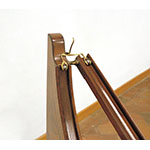This apparatus demonstrates the observable effects of a physical principle discovered by Galileo on November 29, 1602, and communicated by him to Guidobaldo del Monte that day. Using geometrical methods, Galileo proved that a body takes less time to fall along the arc of a circumference than along the corresponding chord—even though the latter is a shorter path. Galileo, who viewed the arc as an infinite set of inclined planes, did not realize that the brachistochrone of a body falling between two points is the arc of a cycloid and not the arc of a circle. The mathematical demonstration of the brachistochronous property of the cycloid was provided by Jacques Bernoulli in 1697.
The device consists of a wooden frame with a cycloidal channel. A straight channel also pivots on the frame, and its inclination can be adjusted by means of pegs fixed in holes with brass rings under the cycloid. Dropping two balls simultaneously down the two channels, we observe that the ball falling down the arc of the cycloid reaches bottom well before the ball traveling down the inclined plane.
This experimental apparatus was built by Francesco Spighi.











